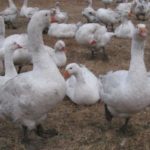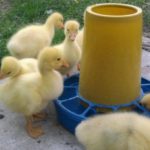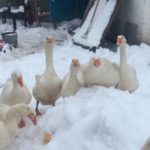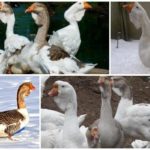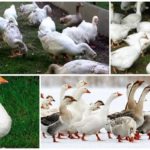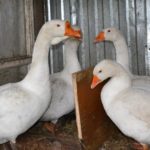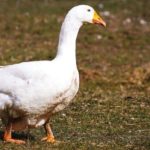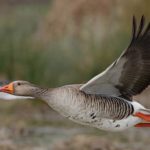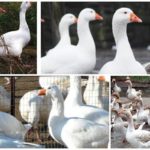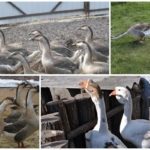Geese are bred as poultry in many farms. Breeds have been developed, old and new, differing in characteristics and appearance. The main advantages of Danish Mamut geese - large size and weight - make this breed promising for breeding at home. Let's consider its description, advantages and disadvantages, rules of feeding, maintenance and care. How to breed and propagate poultry in households.
External characteristics and productivity of Mamut geese
The Danish Mamut was bred by crossing the White Landish goose and gray Toulouse. The name of the breed translates as “big”, which correctly characterizes its representatives. Mamuts entered the territory of Russia and Ukraine in 1996, but remained unofficially registered.
Mamuts are large geese, the weight of a drake is 11-13 kg, and that of geese is 8-10 kg. The body is large, rounded, the head is medium-sized, and the neck is long. The feet and beak (without the cone) are large, bright orange, the feathers are white. Mamut geese begin to lay eggs at 7 months. About 5 dozen eggs are laid per year. Goslings hatch from eggs on days 25-27, the survival rate of chicks is 85%.
Positive and negative sides
As you can see, the advantages of the breed outweigh its disadvantages, therefore Mamuts are recognized as a promising breed, which is recommended for cultivation in private conditions.
Rules of maintenance and care
Raising geese Mamut is considered economical. For summer maintenance, it is enough for them to make a pen and keep them in the fresh air. After the onset of cold weather, birds should be placed in a spacious and warm poultry house. You need to lay a layer of insulating material on the floor: straw, peat, sawdust. The bedding layer should be at least 15 cm. The temperature in winter should not fall below 10 ° C, and the humidity should not exceed 75%.
In addition to temperature and humidity, you need to provide the geese with proper lighting and ventilation. Daylight should last at least 12 hours, both in summer and winter. Every day the room must be ventilated or a ventilation system must be installed in the poultry house. In order for the geese to lay eggs, nests must be placed in the poultry house - one for 2 birds.
What to feed the birds?
Geese of the Mamut breed are distinguished by the fact that they consume no more than 95 kg of feed until adulthood, which is considered a small amount. Adult birds can be fed mixtures of grains of different types, finely ground, with the addition of grass, boiled or fresh grated vegetables, and root vegetables. The mash must be moist. In addition to the main components, it is necessary to replenish the mixtures with premixes, chalk and salt.
For the first 1.5 weeks, small goslings are fed mixtures of boiled eggs, greens, and crushed cereals. Then boiled potatoes are added to them. From 3 weeks of age, goslings can be transferred to feeding with food for adult birds.
Grown goslings and adult Mamut geese can be fed with poultry feed. It is nutritious, fully satisfies the needs of the bird, and is economical. When feeding with mixtures or mixed feed, geese should always have water in their drinking bowls.
Subtleties of breeding
Purebred Mamut goslings are obtained only from purebred geese and ganders. Taking into account that the females of the breed are not distinguished by manifestations of the brooding instinct, the chicks need to be hatched in an incubator. If the incubation rules are followed, the hatching rate of goslings reaches 85%.
Diseases
Geese of the Danish Mamut breed suffer from infectious diseases and helminthiasis. The reasons most often lie in non-compliance with conditions of detention and care.
If the bird is on damp and dirty bedding, eats from dirty feeders, or lives in a cramped room, then infections spread very quickly.
If a sick bird is discovered, it is necessary to immediately isolate it from others so that the infection is not transmitted further. Antibiotics are used for treatment. The course of therapy is carried out until the bird fully recovers. It is impossible to make a diagnosis and carry out treatment on your own; the cause and treatment regimen must be determined by a veterinarian.
In addition to infections, mamuts can suffer from non-infectious diseases - hypovitaminosis, digestive disorders, metabolic diseases. The causes of pathologies are considered to be improper feeding, unbalanced in nutrients. To eliminate the causes, you need to review the diet and introduce new foods into it. After some time the problem should be resolved.
Adult geese may suffer from prolapse of the oviduct, this is due to the fact that they lay large eggs. Another common problem, esophageal blockage, occurs due to feeding dry food. This problem can be avoided if you feed the bird wet bourgeois and even then there should always be clean water in the house. When feeding with compound feed, this condition is mandatory.
Danish Mamut geese are profitable to breed. They eat little, grow quickly, and are heavy. Geese are bred for personal consumption or a small goose farm is organized, which will provide financial profit.



